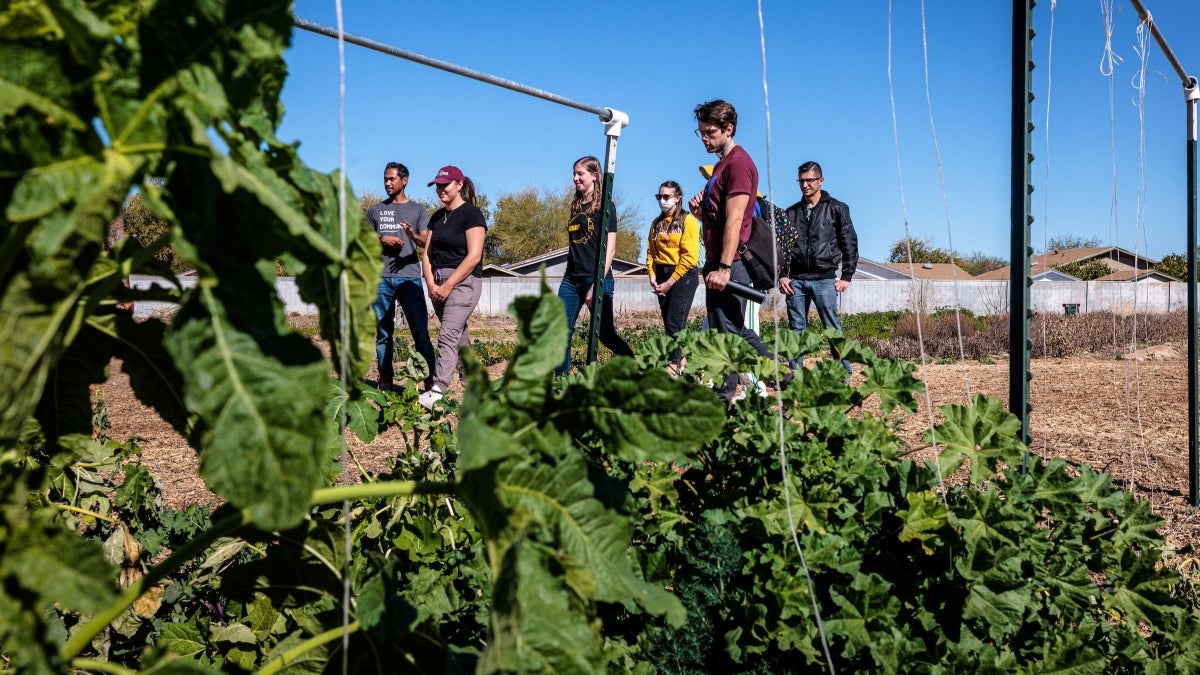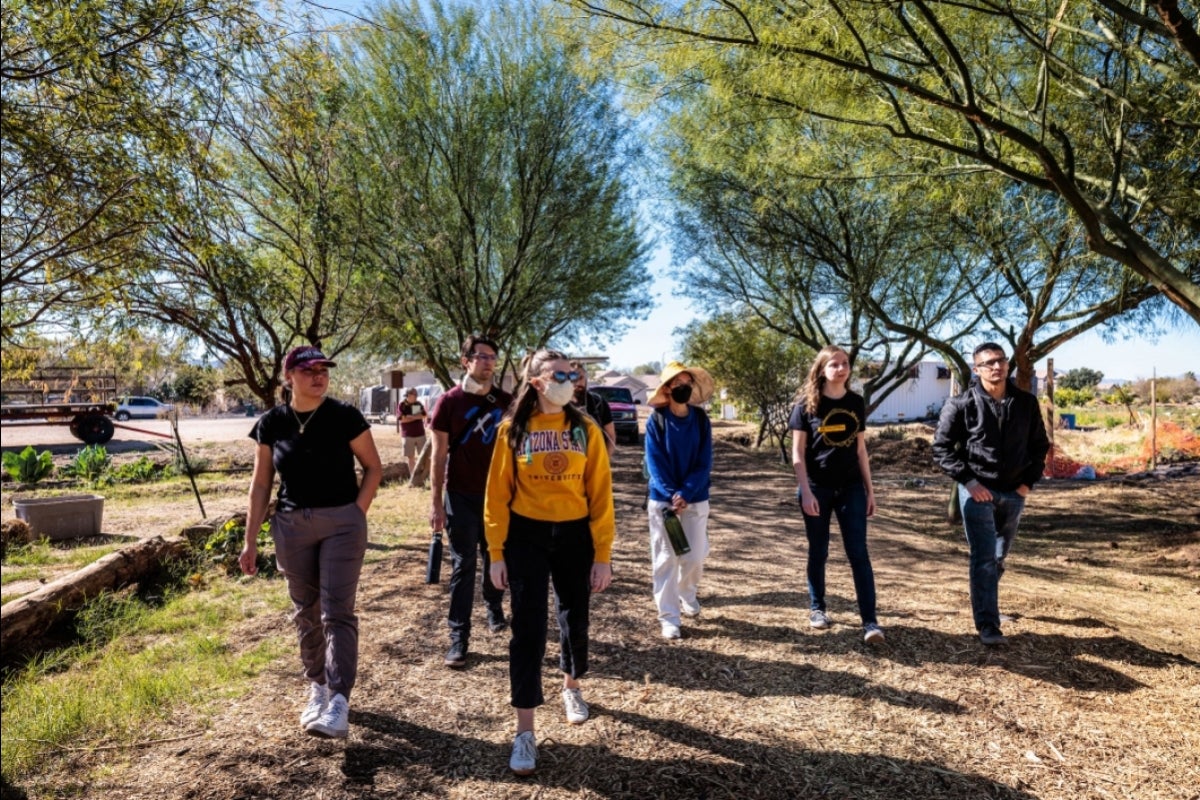It’s 72 degrees on a beautiful Thursday morning as the students in Jose-Benito Rosales Chavez’s Urban Food Systems class gather at Spaces of Opportunity, a community garden near 12th Avenue and Baseline Road.
The students are given a tour of the 19-acre urban farm, where local residents can buy a small plot of land for $5 a month to grow, maintain and then consume the food they nurture.
The farm isn’t in the middle of nowhere; rather it’s an example of how community planning can help serve people in impoverished areas and why, after the class wasn’t taught for four years because the previous professor had retired, Rosales Chavez thought it was important to bring back to Arizona State University’s School of Geographical Sciences and Urban Planning.
“What I want students to learn from this class is we need to work on policies that are equitable so everybody can have access to healthy food,” said Rosales Chavez, who took the class as an ASU student. “And instead of relying on food from other places, we need to find a system that works in the heart of a city."
There’s little question that healthy, affordable and sustainable food sources are needed across the U.S. According to the United States Department of Agriculture’s most recent food access report, published in 2017, nearly 40 million people – 12.8% of the country’s population – were living in low income areas. Of that group, 19 million people had limited access to a grocery store. Also, another 1.6 million rural households in the U.S. don’t have access to a car and need transportation, thus limiting their food opportunities.
“Food deserts are a major issue when you go into certain (low income or rural) neighborhoods, and the larger national stores are not going to open there, and farmer’s markets are not going to open there, and food access is limited to either driving or getting on a transit and going quite a distance,” said Darin Hughes, a graduate student in the class who is getting his master’s degree in urban and environmental planning. “Seeing that dichotomy and understanding the failure of the environment that leads to those conditions was new to me and something I wanted to focus my attention on to an extent.”
For Rosales Chavez, building sustainable communities is not just good policy; it’s a passion born from his personal experience.
He grew up the son of a single mother in Michoacán, a state in western Mexico that has coastline along the Pacific Ocean. He and his mother had access to Mexico’s diverse food system, which included farmer’s markets, tianguis (flea markets), specialty stores, tortilla shops and family-owned dairy shops.
But in the two years before he and his mother moved to the U.S. in 2002, money became tight, thus limiting the access the family had to Mexico’s varied food supply.
“There was a point where all we ate was tortillas and beans,” Rosales Chavez said. “A local farmer would loan us milk, and we wouldn’t pay for one or two months. We lived in an environment that had plenty of food close to us, but we didn’t have the income to buy it.”
Rosales Chavez, then 14 years old, and his mom moved to a low income area in Las Vegas in 2002 and experienced the other side of the food supply conundrum. Thanks to federal government safety net programs, they had money to buy food, but the only stores near them were a convenience store and a grocery store that closed because it wasn’t making enough money.
“So it changed for us from not having an income to not having sources of food,” Rosales Chavez said.
Those experiences influenced Rosales Chavez’s choice for his dissertation, which was published in 2021. He wrote it in three parts. One part was published in the Public Health Nutrition journal and was titled “Availability, variety and distribution of healthy and unhealthy foods and beverages sold at street food stands in Mexico City.”
A second part was published in the Journal of Nutrition Education and Behavior and titled “Development and Interrater Reliability of a Street Food.”
The third part was published in the International Journal of Environmental Research and Public Health. Its title: "Street Food Stand Availability, Density and Distribution Across Income Levels in Mexico City."
Rosales Chavez said the effort to build sustainable communities must be multi-faceted. One step: Obtain land to build more community gardens such as Spaces of Opportunity.
But that cannot be the sole objective, Rosales Chavez said, because some families don’t have either the expertise or the time to take care of their own gardens.
“We just can’t have a program where you expect people to start growing their own things, because it takes time, it takes knowledge and sometimes it doesn’t work for everybody,” he said. “You have people who are maybe working too many jobs, and they don’t have the time to grow their own food. If they don’t have time to be in the field, how is that going to help them?”
That’s why availability and easy access to food is so important. On the 27,000 square miles of the Navajo reservation, for example, there are just 13 full-service grocery stores for a population of more than 300,000. The average resident has to drive three hours to buy food at a grocery store.
“If you go to a rural community, there’s nothing there,” Rosales Chavez said. “They may have a local convenience store, but it’s overpriced. When that happens, people have to compromise. When you have a low-paying job and kids you have to feed, do you buy expensive healthy food, and they’re going to get less of it, or do you buy horrible food you get more of but it’s not nutritious?”
That unwanted choice has health risks. According to the Centers for Disease Control and Prevention (CDC), Native American adults are 50% more likely to be affected by obesity than non-Hispanic whites, and are twice as likely as non-Hispanic whites to have diabetes.
One solution, Rosales Chavez said, can be found in countries where food stands offer healthy, pre-cooked or pre-made meals. One example in Mexico: Vendors that cut up cucumbers and mango to make fruit salads.
“Here, you have what we consider traditional grocery stores,” he said, "but in those places, there’s a much more diverse system. Food stands provide convenient, affordable, culturally relevant food access. Some family members don’t have the resources all the time to cook at home, so as they’re traveling and commuting from home to work or work to home, you can find these stands in the street.”
Rosales Chavez cited the New York City Green Cart program. Vendors who get permits to operate a Green Cart can provide fresh fruits, vegetables, plain nuts and bottled water in neighborhoods that have limited access to fresh produce.
“It’s kind of a way of nudging them to help sell healthy food,” Rosales Chavez said.
Julia O’Neill, a graduate student in the class, said her applied project for the course is determining the barriers some communities face when trying to access healthy food. She’s also discovered the lack of education when it comes to making healthy food choices.
“It’s been a really eye-opening experience,” she said.
Ultimately, Hughes said, the class is about communities taking charge of their environments.
“One of the ways to do that is food and our connections to food,” he said.
Top photo: Sowan Thai (far left), the land manager of Spaces of Opportunity, talks with ASU graduate students in Assistant Professor Jose-Benito Rosales Chavez's (far right) Urban Food Systems class about sustainable community food gardens in low income neighborhoods on Feb. 10. Spaces of Opportunity is a 10-acre incubator farm for Valley residents who have limited resources to grow food. Photo by Charlie Leight/ASU News
More Environment and sustainability

Homes for songbirds: Protecting Lucy’s warblers in the urban desert
Each spring, tiny Lucy’s warblers, with their soft gray plumage and rusty crown, return to the Arizona desert, flitting through the mesquite branches in search of safe places to nest.But as urban…

Public education project brings new water recycling process to life
A new virtual reality project developed by an interdisciplinary team at Arizona State University has earned the 2025 WateReuse Award for Excellence in Outreach and Education. The national …

ASU team creates decision-making framework to improve conservation efficiency
Conserving the world’s ecosystems is a hard job — especially in times of climate change, large-scale landscape destruction and the sixth mass extinction. The job’s not made any easier by the fact…









